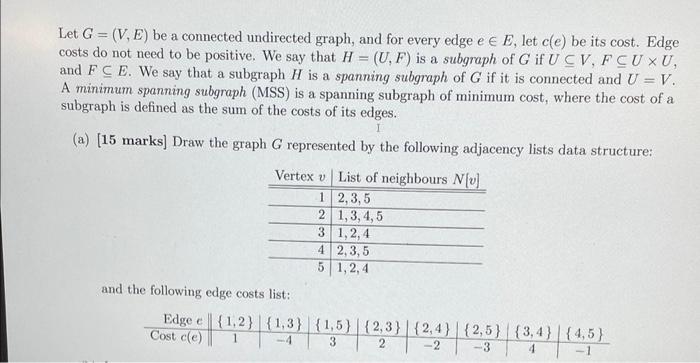Question
= Let G=(V, E) be a connected undirected graph, and for every edge e E, let c(e) be its cost. Edge costs do not

= Let G=(V, E) be a connected undirected graph, and for every edge e E, let c(e) be its cost. Edge costs do not need to be positive. We say that H (U, F) is a subgraph of G if U CV, FCUXU, and FC E. We say that a subgraph H is a spanning subgraph of G if it is connected and U = V. A minimum spanning subgraph (MSS) is a spanning subgraph of minimum cost, where the cost of a subgraph is defined as the sum of the costs of its edges. (a) [15 marks] Draw the graph G represented by the following adjacency lists data structure: Vertex v List of neighbours N[v] 1 2,3,5 2 1,3,4,5 3 1,2,4 4 2,3,5 5 1,2,4 and the following edge costs list: Edge e{1,2} Cost c(e) (1,2) {1,3} {1,5} {2,3} {2,4} {2,5} {3,4} {4,5) }|(4,5) 3 2 -2 -3 4
Step by Step Solution
3.38 Rating (164 Votes )
There are 3 Steps involved in it
Step: 1
The skin friction coefficient Cf for a laminar boundary ...
Get Instant Access to Expert-Tailored Solutions
See step-by-step solutions with expert insights and AI powered tools for academic success
Step: 2

Step: 3

Ace Your Homework with AI
Get the answers you need in no time with our AI-driven, step-by-step assistance
Get StartedRecommended Textbook for
Discrete and Combinatorial Mathematics An Applied Introduction
Authors: Ralph P. Grimaldi
5th edition
201726343, 978-0201726343
Students also viewed these Programming questions
Question
Answered: 1 week ago
Question
Answered: 1 week ago
Question
Answered: 1 week ago
Question
Answered: 1 week ago
Question
Answered: 1 week ago
Question
Answered: 1 week ago
Question
Answered: 1 week ago
Question
Answered: 1 week ago
Question
Answered: 1 week ago
Question
Answered: 1 week ago
Question
Answered: 1 week ago
Question
Answered: 1 week ago
Question
Answered: 1 week ago
Question
Answered: 1 week ago
Question
Answered: 1 week ago
Question
Answered: 1 week ago
Question
Answered: 1 week ago
Question
Answered: 1 week ago
Question
Answered: 1 week ago
Question
Answered: 1 week ago
Question
Answered: 1 week ago
Question
Answered: 1 week ago
View Answer in SolutionInn App



